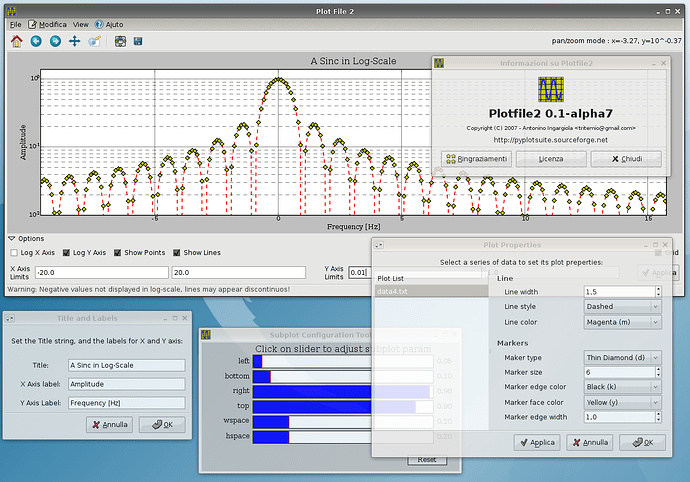Hi,
I have written a small pygtk script to allow dynamic editing of the
current graphs. It is useful in interactive use of matplotlib. It can
handle figures, axes, text, images, lines properties. You can copy lines
from one axes to an other one or delete elements. Finally you can save
the data in ASCII. Before doing more developments, I'd like to know if
such a tool already exists. Otherwise, your comments are welcome.
Hi Antonione --
this is a nice start. A couple of suggestions
* you may want to use a gtk.Table for your label/entry pairs in your
dialog editor. Everything will line up much more nicely
* you should not explicitly require pygtk 2.0. Noone is using pygtk1
anymore and this will cause some pygth2 installations to fail (like
mine!)
* you may want to look at the line editor dialog in backend_gtk.py for
inspiration. This uses drop down menus for linestyles, color dialog
boxes to pick colors, etc... I'll paste in the code below
Thanks,
JDH
class DialogLineprops:
"""
A GUI dialog for controlling lineprops
"""
signals = (
'on_combobox_lineprops_changed',
'on_combobox_linestyle_changed',
'on_combobox_marker_changed',
'on_colorbutton_linestyle_color_set',
'on_colorbutton_markerface_color_set',
'on_dialog_lineprops_okbutton_clicked',
'on_dialog_lineprops_cancelbutton_clicked',
)
linestyles = (
'-' ,
'--' ,
'-.' ,
',' ,
'steps',
'None' ,
)
linestyled = dict([ (s,i) for i,s in enumerate(linestyles)])
markers = (
'None',
'.' ,
',' ,
'o' ,
'v' ,
'^' ,
'<' ,
'>' ,
'1' ,
'2' ,
'3' ,
'4' ,
's' ,
'p' ,
'h' ,
'H' ,
'+' ,
'x' ,
'D' ,
'd' ,
'|' ,
'_' ,
)
markerd = dict([(s,i) for i,s in enumerate(markers)])
def __init__(self, lines):
datadir = matplotlib.get_data_path()
gladefile = os.path.join(datadir, 'lineprops.glade')
if not os.path.exists(gladefile):
raise IOError('Could not find gladefile lineprops.glade in
%s'%datadir)
self._inited = False
self._updateson = True # suppress updates when setting widgets manually
self.wtree = gtk.glade.XML(gladefile, 'dialog_lineprops')
self.wtree.signal_autoconnect(dict([(s, getattr(self, s)) for
s in self.signals]))
self.dlg = self.wtree.get_widget('dialog_lineprops')
self.lines = lines
cbox = self.wtree.get_widget('combobox_lineprops')
cbox.set_active(0)
self.cbox_lineprops = cbox
cbox = self.wtree.get_widget('combobox_linestyles')
for ls in self.linestyles:
cbox.append_text(ls)
cbox.set_active(0)
self.cbox_linestyles = cbox
cbox = self.wtree.get_widget('combobox_markers')
for m in self.markers:
cbox.append_text(m)
cbox.set_active(0)
self.cbox_markers = cbox
self._lastcnt = 0
self._inited = True
def show(self):
'populate the combo box'
self._updateson = False
# flush the old
cbox = self.cbox_lineprops
for i in range(self._lastcnt-1,-1,-1):
cbox.remove_text(i)
# add the new
for line in self.lines:
cbox.append_text(line.get_label())
cbox.set_active(0)
self._updateson = True
self._lastcnt = len(self.lines)
self.dlg.show()
def get_active_line(self):
'get the active line'
ind = self.cbox_lineprops.get_active()
line = self.lines[ind]
return line
def get_active_linestyle(self):
'get the active lineinestyle'
ind = self.cbox_linestyles.get_active()
ls = self.linestyles[ind]
return ls
def get_active_marker(self):
'get the active lineinestyle'
ind = self.cbox_markers.get_active()
m = self.markers[ind]
return m
def _update(self):
'update the active line props from the widgets'
if not self._inited or not self._updateson: return
line = self.get_active_line()
ls = self.get_active_linestyle()
marker = self.get_active_marker()
line.set_linestyle(ls)
line.set_marker(marker)
button = self.wtree.get_widget('colorbutton_linestyle')
color = button.get_color()
r, g, b = [val/65535. for val in color.red, color.green, color.blue]
line.set_color((r,g,b))
button = self.wtree.get_widget('colorbutton_markerface')
color = button.get_color()
r, g, b = [val/65535. for val in color.red, color.green, color.blue]
line.set_markerfacecolor((r,g,b))
line.figure.canvas.draw()
def on_combobox_lineprops_changed(self, item):
'update the widgets from the active line'
if not self._inited: return
self._updateson = False
line = self.get_active_line()
ls = line.get_linestyle()
if ls is None: ls = 'None'
self.cbox_linestyles.set_active(self.linestyled[ls])
marker = line.get_marker()
if marker is None: marker = 'None'
self.cbox_markers.set_active(self.markerd[marker])
r,g,b = colorConverter.to_rgb(line.get_color())
color = gtk.gdk.Color(*[int(val*65535) for val in r,g,b])
button = self.wtree.get_widget('colorbutton_linestyle')
button.set_color(color)
r,g,b = colorConverter.to_rgb(line.get_markerfacecolor())
color = gtk.gdk.Color(*[int(val*65535) for val in r,g,b])
button = self.wtree.get_widget('colorbutton_markerface')
button.set_color(color)
self._updateson = True
def on_combobox_linestyle_changed(self, item):
self._update()
def on_combobox_marker_changed(self, item):
self._update()
def on_colorbutton_linestyle_color_set(self, button):
self._update()
def on_colorbutton_markerface_color_set(self, button):
'called colorbutton marker clicked'
self._update()
def on_dialog_lineprops_okbutton_clicked(self, button):
self._update()
self.dlg.hide()
def on_dialog_lineprops_cancelbutton_clicked(self, button):
self.dlg.hide()
···
On 6/19/07, Antoine Sirinelli <matplotlib-users@...1652...> wrote:
You can find the script here (Quick & Dirty coding style) :
http://mpl-properties.googlecode.com/svn/trunk/mpl_properties.py
to test it, in an interactive pylab session with figures and plots, just
type these 2 commands:
import mpl_properties
mpl_properties.properties()
Antoine
-------------------------------------------------------------------------
This SF.net email is sponsored by DB2 Express
Download DB2 Express C - the FREE version of DB2 express and take
control of your XML. No limits. Just data. Click to get it now.
http://sourceforge.net/powerbar/db2/
_______________________________________________
Matplotlib-users mailing list
Matplotlib-users@lists.sourceforge.net
matplotlib-users List Signup and Options
